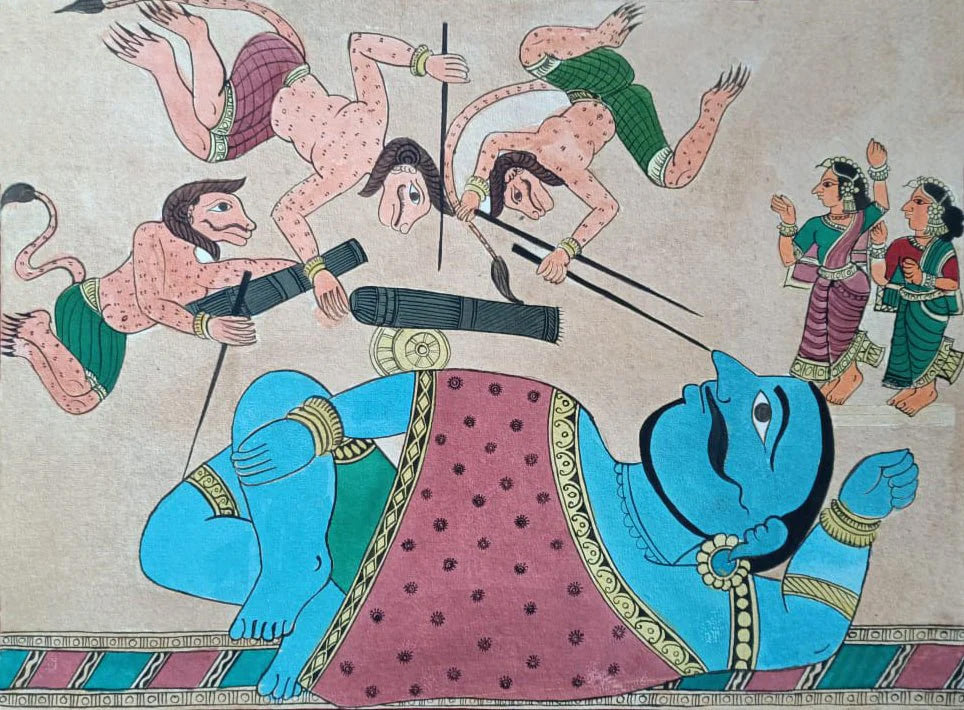Chitrakathi is a traditional Indian art form that combines storytelling with painting, originating from the rural regions of Maharashtra, particularly in the areas of Paithan and Pinguli. This ancient art involves the use of vividly painted scrolls or paper sheets that narrate stories from epics like the Ramayana and Mahabharata. Chitrakathi artists, known as Chitrakars, use these paintings as visual aids while performing narratives, making it an engaging and interactive experience for their audiences. The art form is a unique blend of visual and performing arts, preserving age-old stories and cultural heritage through its distinctive style and vibrant colors.
Chitrakathi primarily revolves around themes from Hindu mythology, with the Ramayana and Mahabharata being the most frequently depicted narratives. Stories of gods and goddesses, epic battles, and moral dilemmas are brought to life through the paintings. The themes often reflect the values and beliefs of the community, emphasizing virtues like courage, devotion, and righteousness. Besides religious epics, some Chitrakathi works also depict local folklore, everyday village life, and moral tales, making the art form a rich tapestry of storytelling that resonates with diverse audiences.
History
The history of Chitrakathi can be traced back to the 17th century, where it served as a popular medium for entertainment and education in rural communities. Rooted in the tradition of oral storytelling, Chitrakathi evolved as a way to bring stories to life through visual representation. The Chitrakars were often invited to perform at temples, fairs, and village gatherings, where they would narrate episodes from Hindu epics, accompanied by music and song. Over time, Chitrakathi became not only a means of entertainment but also a tool for imparting moral lessons and religious teachings. Despite its rich heritage, Chitrakathi has faced challenges due to modernization and a decline in traditional patronage, but efforts are being made to revive and sustain this unique art form.
The style of Chitrakathi is characterized by its bold lines, bright colors, and expressive figures. The paintings are not highly detailed but rather focus on the essence of the story, with clear and exaggerated expressions to convey emotions effectively. The figures are often depicted in profile, with minimal background, allowing the narrative to take center stage. The simplicity and directness of the style make it accessible and engaging, appealing to both children and adults. Each painting is a part of a larger sequence that unfolds the story, much like frames in a film, and is designed to be shown one after another during the performance.
Materials and Methods
Chitrakathi paintings are traditionally made on paper or cloth using natural dyes and pigments. The artists use bold lines drawn with bamboo pens and fill in colors using brushes made from natural fibers. Common colors include red, yellow, green, and black, derived from locally available minerals, plants, and other natural sources. The preparation of these colors is a meticulous process, involving grinding, mixing, and boiling ingredients to achieve the desired hues. The paintings are then mounted on scrolls or panels and used during performances, where the Chitrakar narrates the story, often accompanied by music played on traditional instruments like the tabla and harmonium.
Significance
Chitrakathi holds significant cultural and historical value as a traditional Indian art form that bridges the gap between visual and performing arts. It serves as a living archive of India’s rich mythological and cultural heritage, preserving stories and customs that have been passed down for generations. The art form also plays a crucial role in community bonding, bringing people together through shared experiences of storytelling and performance. In an era where digital media dominates, Chitrakathi offers a tangible and interactive connection to India’s past, highlighting the importance of oral traditions and the power of visual storytelling. Efforts to preserve and promote Chitrakathi include workshops, exhibitions, and collaborations with contemporary artists and designers, ensuring that this ancient art continues to inspire and educate future generations.
FAQs
Are Chitrakathi paintings available for purchase?
Yes, Chitrakathi paintings can be purchased from traditional artisans, craft fairs, and online platforms like MeMeraki that specialize in Indian folk arts. Buying these paintings supports the artisans and helps keep the tradition alive.
Can Chitrakathi be used for educational purposes?
Yes, Chitrakathi is a powerful educational tool that teaches moral lessons, religious stories, and cultural values through visual storytelling. It can be used in schools and community programs to engage children and adults alike.
















